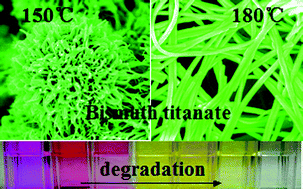The shape-controlled synthesis of hierarchically micro- and nanostructured materials has provided new possibilities to improve their physical and chemical properties. In this work, Bi12TiO20 complex architectures, such as nanospheres, nanowires, microflowers and microspheres were prepared through a facile solution-phase hydrothermal process, by controlling the reaction parameters, such as temperature, reagent concentration, and reaction time. Within the hydrothermal temperature range from 150 to 180 °C, the morphology transformed progressively from nanosphere agglomerates to microflowers, nanowires and then to microspheres with increasing time. A possible growth mechanism is proposed to explain the transformation of nanoparticles to microflowers via an Ostwald ripening mechanism followed by self-assembly and then break-up of the microflowers to nanowires and final consolidation into microspheres. Most importantly, these Bi12TiO20 samples dependent on their shape, size, and crystallinity, displayed high photocatalytic activities in comparison with bulk bismuth titanate powders, as demonstrated by the degradation of Rhodamine B under visible-light irradiation. The reasons for the difference in the photocatalytic properties of these Bi12TiO20 architectures are further investigated.

You have access to this article
 Please wait while we load your content...
Something went wrong. Try again?
Please wait while we load your content...
Something went wrong. Try again?


 Please wait while we load your content...
Please wait while we load your content...